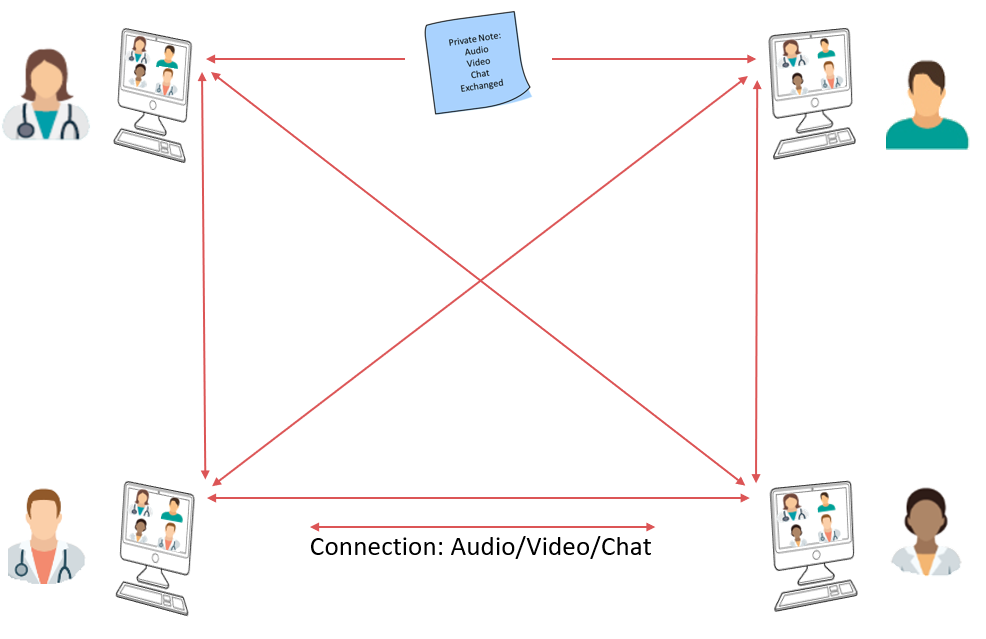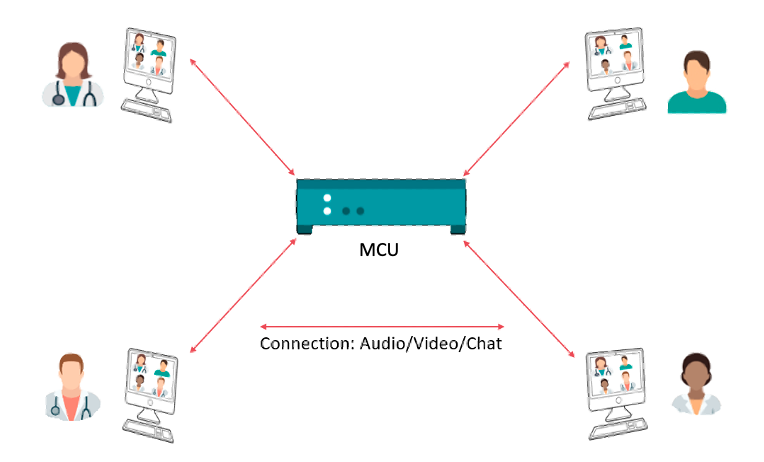This article outlines why healthdirect Video Call in multi-party consultations sometimes appears to work differently to other platforms such as Skype/Zoom/Google Meet. It also highlights why it is important to understand the difference in relation to clinical consultations.
Overview: Traditional video conferencing systems architecturally use a network element called MCU (Multipoint Conferencing Unit) while Video Call uses a Peer-To-Peer or "Mesh" network. 'Peer' in this instance refers to computer systems that are connected to one another via the internet. We will highlight the differences between these two methods below.
Peer-to-Peer (Mesh)
Imagine there is no internet and you need to communicate with your patients through the delivery of written notes. Your notes contain very personal information and you do not trust any external courier to deliver them. So you deliver them yourself, in person, directly to your patient’s residence. It is time consuming making copies of your notes for each patient and driving around to deliver them individually. However, because you hand deliver your notes yourself, you are confident that no personal information is divulged to anyone else.
|
Peer-to-Peer example: In this diagram each Participant has three peer-to-peer bi-directional connections with remote ends (other participants in the call). For an average 1Mbps connection this equates to each user sending 3Mbps and receiving 3Mbps. All processing tasks are completed by the end device (each participant's device). |
 |
Multipoint Conferencing Unit (MCU)
Over time, you have many more patients and your process does not scale and becomes unsustainable, hence the need to optimise. You have heard about a company in town which owns a fast photo copier and also offers courier services to pickup the originals and deliver copies. You contact this company and ask them to pick up your personal notes from your residence, make a few copies and deliver one copy to each of your patients. You are very happy with their service as it saves you plenty of time but… you do not factor in that a person who makes copies of your notes can potentially read them, make personal copies and deliver them to incorrect residences so other people may wrongly get to read them too.
One day you open up your daily newspaper and, to your horror, realise that your personal note is published there, disclosing private information! You may blame the newspaper, the couriers, the copier and others, but the cause was actually the communication process used compared with the hand-delivery of the personal notes.
|
MCU example: In this diagram each Participant has one connection with the network multi-party conferencing unit (eg Zoom or Skype). For an average 1mbps connection this equates to each user sending only 1Mbps and receiving a max of 3Mbps. Almost all processing is completed by the MCU. |
 |
Security and Privacy
When you hand delivered your notes, you came around to your patient’s residence in their absence, opened the front door and placed your private note directly on their desk. Due to increased burglaries, however, your patients started to lock their doors. To facilitate your hand delivery of notes they gave you keys to their residences – you just unlocked their residence when you brought your note for them. Then, when you engaged the services of a copier/courier company in order to facilitate the deliveries, you passed them the keys to your patient’s residences, forgetting to ask your patients for permission to pass their keys to someone else. From that point on, couriers had unhindered access to your patients’ residences and could use the keys for more than just delivery of notes while your patients were out.
So, in effect, the MCU (Multipoint Conferencing Unit) is the photocopier/courier in this communication path scenario. It facilitates delivery and propagation of your video. It does it very quickly because it uses fast machines connected to high speed internet. And that’s why video conferencing platforms which use MCU technology often perform better in large video conferences. However, it does so at cost of ‘man in the middle’ security and privacy.
It is also important to consider the capacity and associated costs of the photocopier/courier in the process. Video Call does not use an MCU, it uses peer-to-peer delivery and thus it is your personal device and your internet connection that hold the responsibility for making and delivering copies of your video to all your patients/participants in the consultation. If your internet is not fast/stable or your device is not fast/powerful enough, you may experience a lower quality of video in your consultation compared with MCU enabled platforms.
Another important point to bear in mind is the location of the company's MCUs in the network. They may be located outside of Australian jurisdiction, which risks your data going offshore. As privacy and security is paramount to clinical consultations, Video Call does not use MCU technology and is designed specifically with privacy and security in mind.
Conclusion
Although you may see a slightly better performance in larger participant conferences on other platforms that are using an MCU, they do not have the same security measures in place that direct mesh/peer-to-peer network connections provide. MCU consultations by design may alter, store, record or reduce the quality of your sessions. With peer-to-peer/mesh connections this is not possible as there is no network element in the 'middle'.